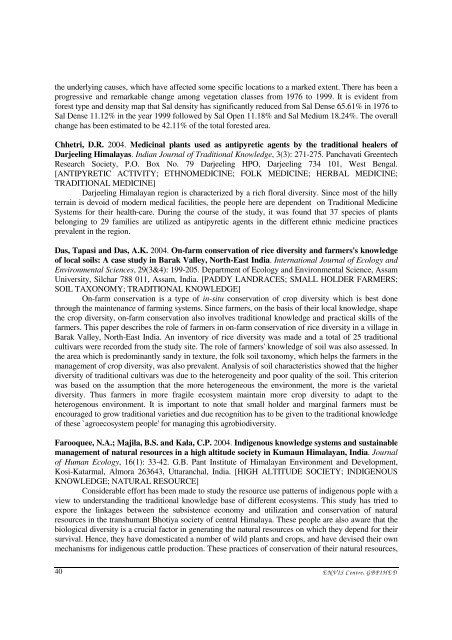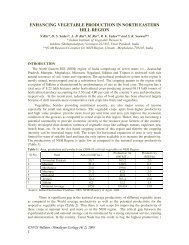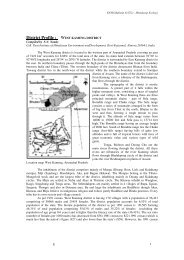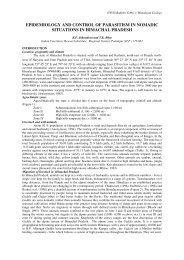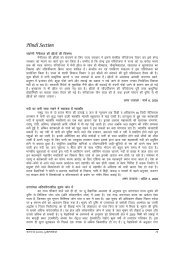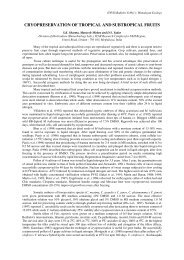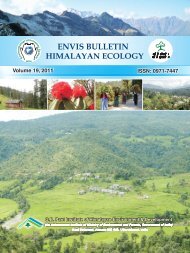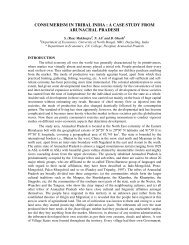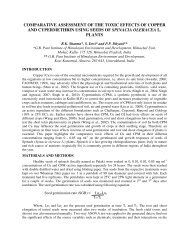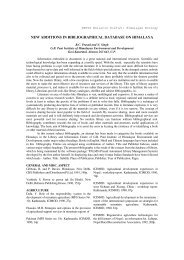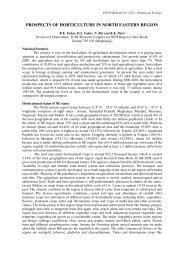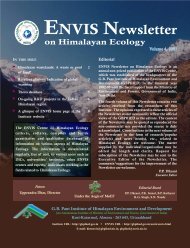the underlying causes, which have affected some specific locati<strong>on</strong>s to a marked extent. There has been aprogressive and remarkable change am<strong>on</strong>g vegetati<strong>on</strong> classes from 1976 to 1999. It is evident fromforest type and density map that Sal density has significantly reduced from Sal Dense 65.61% in 1976 toSal Dense 11.12% in the year 1999 followed by Sal Open 11.18% and Sal Medium 18.24%. The overallchange has been estimated to be 42.11% of the total forested area.Chhetri, D.R. 2004. Medicinal plants used as antipyretic agents by the traditi<strong>on</strong>al healers ofDarjeeling Himalayas. Indian Journal of Traditi<strong>on</strong>al Knowledge, 3(3): 271-275. Panchavati GreentechResearch Society, P.O. Box No. 79 Darjeeling HPO, Darjeeling 734 101, West Bengal.[ANTIPYRETIC ACTIVITY; ETHNOMEDICINE; FOLK MEDICINE; HERBAL MEDICINE;TRADITIONAL MEDICINE]Darjeeling <strong>Himalayan</strong> regi<strong>on</strong> is characterized by a rich floral diversity. Since most of the hillyterrain is devoid of modern medical facilities, the people here are dependent <strong>on</strong> Traditi<strong>on</strong>al MedicineSystems for their health-care. During the course of the study, it was found that 37 species of plantsbel<strong>on</strong>ging to 29 families are utilized as antipyretic agents in the different ethnic medicine practicesprevalent in the regi<strong>on</strong>.Das, Tapasi and Das, A.K. 2004. On-farm c<strong>on</strong>servati<strong>on</strong> of rice diversity and farmers's knowledgeof local soils: A case study in Barak Valley, North-East India. Internati<strong>on</strong>al Journal of <strong>Ecology</strong> andEnvir<strong>on</strong>mental Sciences, 29(3&4): 199-205. Department of <strong>Ecology</strong> and Envir<strong>on</strong>mental Science, AssamUniversity, Silchar 788 011, Assam, India. [PADDY LANDRACES; SMALL HOLDER FARMERS;SOIL TAXONOMY; TRADITIONAL KNOWLEDGE]On-farm c<strong>on</strong>servati<strong>on</strong> is a type of in-situ c<strong>on</strong>servati<strong>on</strong> of crop diversity which is best d<strong>on</strong>ethrough the maintenance of farming systems. Since farmers, <strong>on</strong> the basis of their local knowledge, shapethe crop diversity, <strong>on</strong>-farm c<strong>on</strong>servati<strong>on</strong> also involves traditi<strong>on</strong>al knowledge and practical skills of thefarmers. This paper describes the role of farmers in <strong>on</strong>-farm c<strong>on</strong>servati<strong>on</strong> of rice diversity in a village inBarak Valley, North-East India. An inventory of rice diversity was made and a total of 25 traditi<strong>on</strong>alcultivars were recorded from the study site. The role of farmers' knowledge of soil was also assessed. Inthe area which is predominantly sandy in texture, the folk soil tax<strong>on</strong>omy, which helps the farmers in themanagement of crop diversity, was also prevalent. Analysis of soil characteristics showed that the higherdiversity of traditi<strong>on</strong>al cultivars was due to the heterogeneity and poor quality of the soil. This criteri<strong>on</strong>was based <strong>on</strong> the assumpti<strong>on</strong> that the more heterogeneous the envir<strong>on</strong>ment, the more is the varietaldiversity. Thus farmers in more fragile ecosystem maintain more crop diversity to adapt to theheterogenous envir<strong>on</strong>ment. It is important to note that small holder and marginal farmers must beencouraged to grow traditi<strong>on</strong>al varieties and due recogniti<strong>on</strong> has to be given to the traditi<strong>on</strong>al knowledgeof these `agroecosystem people' for managing this agrobiodiversity.Farooquee, N.A.; Majila, B.S. and Kala, C.P. 2004. Indigenous knowledge systems and sustainablemanagement of natural resources in a high altitude society in Kumaun <strong>Himalayan</strong>, India. Journalof Human <strong>Ecology</strong>, 16(1): 33-42. G.B. Pant Institute of <strong>Himalayan</strong> Envir<strong>on</strong>ment and Development,Kosi-Katarmal, Almora 263643, Uttaranchal, India. [HIGH ALTITUDE SOCIETY; INDIGENOUSKNOWLEDGE; NATURAL RESOURCE]C<strong>on</strong>siderable effort has been made to study the resource use patterns of indigenous pople with aview to understanding the traditi<strong>on</strong>al knowledge base of different ecosystems. This study has tried toexpore the linkages between the subsistence ec<strong>on</strong>omy and utilizati<strong>on</strong> and c<strong>on</strong>servati<strong>on</strong> of naturalresources in the transhumant Bhotiya society of central Himalaya. These people are also aware that thebiological diversity is a crucial factor in generating the natural resources <strong>on</strong> which they depend for theirsurvival. Hence, they have domesticated a number of wild plants and crops, and have devised their ownmechanisms for indigenous cattle producti<strong>on</strong>. These practices of c<strong>on</strong>servati<strong>on</strong> of their natural resources,40E N V IS C entre, G B P IH E D
has ensured their survival in extreme in hospitable envir<strong>on</strong>mental c<strong>on</strong>diti<strong>on</strong>s of high altitudes. But, nowtheir indigenous knowledge and practices are <strong>on</strong> the verge of extincti<strong>on</strong>, due to the integrati<strong>on</strong> of theirsociety with the main stream of other societies and market ec<strong>on</strong>omy.Garbyal, S.S.; Aggarwal, K.K. and Babu, C.R. 2004. Impact of Cordyceps sinensis in the ruralec<strong>on</strong>omy of interior villages of Dharchula sub-divisi<strong>on</strong> of Kuma<strong>on</strong> Himalayas and its implicati<strong>on</strong>sin the society. Indian Journal of Traditi<strong>on</strong>al Knowledge, 3(2): 182-186. School of Biotechnology, GuruGobind Singh Indraprastha University, Kashmire Gate, Delhi 110 006; Department of Botany,University of Delhi, Delhi 110 007. [ANTI-BIOTIC PROPERTIES; CATERPILLAR FUNGUS;MUMMIFIED INSECT; PARASITIC FUNGUS; RURAL ECONOMY; TIBETAN MEDICINE]Cordyceps sinensis bel<strong>on</strong>ging to family Clavicipitaceae is a parasitic fungus <strong>on</strong> Lepidopteranlarvae. It occurs at an altitude over 4,000 m and is known to be found in Chipla, Malpa top, Njyang top,Karschila, Budhi Galja, Chal, Baling, B<strong>on</strong>, Dugtu, Panchachuli, Nampa and Api in DharchulaHimalayas. Cordyceps is known to be used for many centuries as t<strong>on</strong>ic, medicine, and aphrodisiac andin religious cerem<strong>on</strong>ies in China, Ind<strong>on</strong>esia and upper Himalayas. Since last 4-5 years Cordyceps hasbeen traded very extensively in Dharchula area of Pithoragarh District in Uttaranchal. It has hadtremendous impact <strong>on</strong> the rural ec<strong>on</strong>omy of the villages in Dharchula area. Local people have beengetting about Rs. 55,000-65,000 per kg. there by improving the living c<strong>on</strong>diti<strong>on</strong>s of many poor villagers.Gurmet, Padma 2004. "Sowa - Rigpa" : <strong>Himalayan</strong> art of healing. Indian Journal of Traditi<strong>on</strong>alKnowledge, 3(2): 212-218. Amchi Medicine Research Unit (CCRAS), Ministry of Health and FamilyWelfare, Govt. of India, Leh, Ladakh, J&K, India. [AMCHI; SOWA-RIGPA; TIBETAN MEDICINE]Sowa-Rigpa comm<strong>on</strong>ly known as Tibetan or Amchi medicine is am<strong>on</strong>g the oldest survivingwell-documented medical traditi<strong>on</strong>s of the world. With the living history of more than 2500 years it hasbeen popularly practiced in <strong>Himalayan</strong> regi<strong>on</strong>s throughout central Asia. In India it has been popularlypracticed in Ladakh, Himachal Pradesh, Arunachal Pradesh, Sikkim, Darjeeling and now in Tibetansettlements all over India. Originated from India Sowa-Rigpa is based <strong>on</strong> Jung-wa-Ina (PanchMahabhuta/five elements) and Nespa-gsum (Tri-dosh/ three humours) theories. According to these allanimate and inanimate phenomena of this universe are composed of Jung-wa-Ina (five elements). It is<strong>on</strong> the theory of five basic elements that the science of physiology, pathology and pharmacology isestablished. This paper gives an introductory note <strong>on</strong> history, theory and practice of Sowa-Rigpa(Science of healing) in India.Joshi, B.K. 2003. Soil nutrient dynamics in different forest-ecosystem in Almora-Binsar area ofCentral Himalaya. Journal of soil and Water C<strong>on</strong>servati<strong>on</strong>, 2(3&4): 121-128. G.B. Pant Institute of<strong>Himalayan</strong> Envir<strong>on</strong>ment and Development, Kosi-Katarmal, Almora 263 643, Uttaranchal, India.[FOREST ECOSYSTEM; LEAF LITTER; SANCTUARY; SOIL NUTRIENTS]Open grazing, burning and other human encroachment increasingly threaten for the forestecosystem of the temperate hill Indian Himalaya. At present these are practiced as multiple uses,including maintaining the envir<strong>on</strong>mental balance of the regi<strong>on</strong>. The present study was c<strong>on</strong>ducted toassess the effect of the human encroachments in different forest ecosystems and discuss the prospectsfor improving their requirement by initiati<strong>on</strong> of community forestry, in the c<strong>on</strong>text of regulardeteriorati<strong>on</strong> in forest ecosystem. Total six types of forest were c<strong>on</strong>sidered for the present investigati<strong>on</strong>,are both natural and planted <strong>on</strong>e, including herb, shrubs and tree canopy. It is observed that the woodypatches with grass are affected by frequent grazing, leaf litter collecti<strong>on</strong> and forest fire interferences. Theresults revealed that the forest fire affected site al<strong>on</strong>g with grazing was with lowest soil moisture;organic carb<strong>on</strong> and nitrogen c<strong>on</strong>tent and significantly varied with other sites for most of the soilcharacteristics. The community forestry and protected sanctuary provide a certain good quality ofgrasses and subsistence, covering emergency needs and many forest by products. Moreover it augmentE N V IS B ulletin : H im alayan E cology 12(2), 2004 41
- Page 6 and 7: after year (Gosh, 1984). In North E
- Page 8 and 9: Future thrustThe followings are the
- Page 10 and 11: Table 1: State wise area and produc
- Page 12 and 13: Table 2: Performance of tomato vari
- Page 14 and 15: durable, about 5-6 times costlier,
- Page 16 and 17: IS GOAT FARMING A THREAT TO ECOLOGY
- Page 18 and 19: Bank officers’ viewAll the bank o
- Page 20: FOREST FRAGMENTATION : A THREAT TO
- Page 23 and 24: (ii)(iii)(iv)Area insensitive speci
- Page 25 and 26: ability to nest in the matrix area
- Page 27 and 28: Management actionsLand management e
- Page 29 and 30: Laurance, W. F and Bierregaard, Jr.
- Page 31 and 32: Sample surveyThe present study is b
- Page 33 and 34: Agricultural sectorBiomass from agr
- Page 35 and 36: anches, roots and wood chips etc. D
- Page 37 and 38: GoI, 2001. Report of the Working Gr
- Page 39: over use and misuse of forests but
- Page 43 and 44: Kar, A. 2004. Common wild vegetable
- Page 45 and 46: test sites at Shimla and Nahan usin
- Page 47 and 48: performance for drought tolerance)
- Page 49 and 50: een assigned to different preceding
- Page 51 and 52: of Himalayan Environment and Develo
- Page 53 and 54: (2%). Total protein content varied
- Page 55 and 56: wheat flour slurry) and 'Malera' (p
- Page 57 and 58: Uniyal, V.P. 2004. Butterflies of N
- Page 59 and 60: N ew s & V iew sNumber of leopards
- Page 61 and 62: also discourage them intake thes dr
- Page 63 and 64: and fauna, Sikkim is redited with h
- Page 65 and 66: i{kksa ij v/;;u fd, tk pqds gSA Hkw
- Page 67 and 68: laLFkku caxykSj esa izksQslj fouksn
- Page 69 and 70: aa/kku dh ikjEifjd iztkfr;ksa ds la
- Page 71 and 72: aaQwyksyksaa dh ?kkVh% % ,d izLrkfo
- Page 73: dVku dks viuh ewlyknkj tM+ksa ds dk


